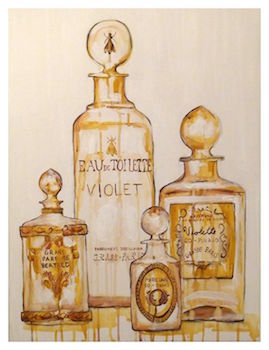Product Description
Van Cleef & Arpels, NY gem set floral perfume bottle in 14k rose gold set with 5 round cut natural rubies, c.1938 (left) & Cartier Art Deco “Candle or Flame” portable perfume bottle in 14k gold, c.1930’s



Van Cleef & Arpels, NY gem set floral perfume bottle in 14k rose gold set with 5 round cut natural rubies, c.1938 (left) & Cartier Art Deco “Candle or Flame” portable perfume bottle in 14k gold, c.1930’s
Cristalleries du val Saint-Lambert (1826-) Belgium
Jemepper-Sur-Meuse
Gevaert Romain/Ledru Leon
“Oignon de Jemeppe” art glass vase c. 1900
Hand blown coffee colored art glass vase with pulled feathering decoration in a burgundy-brown coloration with an elongated neck pulled from a bulbous body.
Marks: VSL (the mark is a variant colored feather pulled detail in the glass on the bottom of the vase)
H: 15 3/8″ x D: 5 3/4″
Price: $12,500
Val Saint Lambert is a Belgian crystal glassware manufacturer, founded in 1826. Val St Lambert is the official glassware supplier to H.M. King Albert II of Belgium.
Val Saint Lambert was founded in the Val-Saint-Lambert Abbey by a chemist, M. Kemlin, who had previously worked for the Vonêche crystal works in the Ardennes. Val Saint Lambert is renowned for its Art Nouveau and Art Deco pieces.
